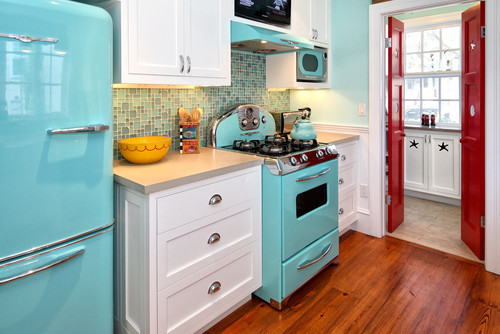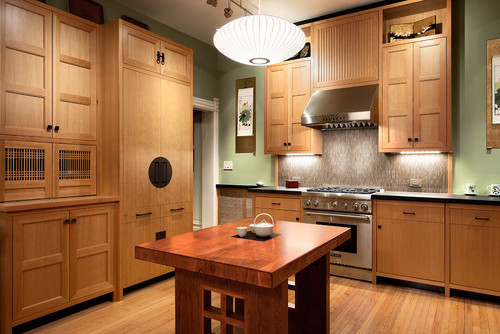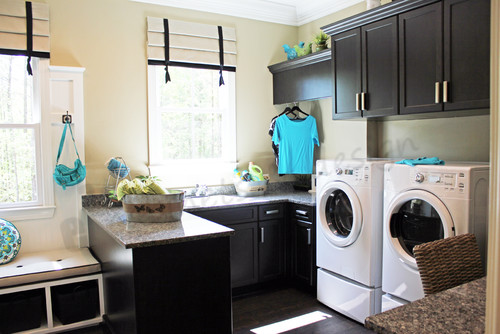Here's Help for Your Next Appliance Shopping Trip
 Wednesday, August 21, 2013 at 9:10AM
Wednesday, August 21, 2013 at 9:10AM Article By: Vanessa Brunner
When shopping for new appliances or planning your dream kitchen, the first step is to do some hard thinking about what you really need, how your kitchen is laid out and the way you live and cook.
What kind of cook are you? Do you want to go ecofriendly? Mix vintage appliances with new? Will multiple generations be using the kitchen? What's the best refrigerator shape and style for your household? Once you've addressed the necessities, consider special features like a warming drawer or wine fridge to make cooking and entertaining easier and more fun.
There's a lot to consider. Start your planning with these practical guides to selecting appliances, along with plenty of photos to inspire you.
Find the right appliance layout. Is the kitchen work triangle dead? To some this kitchen layout plan seems antiquated; to others it's vital. Regardless of your point of view, the work triangle has some important aspects that can help you plan your kitchen appliance layout.
Go the ecofriendly route. Stop smacking your head against the wall every time your electricity bill comes. Choosing and using your appliances wisely can help cut down on your bills and your carbon footprint.
Look beyond stainless steel. Many homeowners are looking for a change from stainless steel. Mix things up a bit with warm white. The right finish and applications work well in traditional, vintage and modern kitchens.
What's old is new again. The charm of vintage and retro appliances can be appreciated by almost everyone. But not everyone finds the work involved in finding, repairing and maintaining these appliances worth it. See if this investment is worth your while.
Embrace universal design. Design your new kitchen for today and tomorrow. Whether you're living in your "forever" home or want to accommodate special needs right now, these appliances can contribute to a universally designed kitchen that everyone's comfortable in.
Specific Appliances
Ovens. Gone are the days when ovens had to be placed right under the range. Today oven arrangements have more to do with the confines of a kitchen and with individual cooking styles than with appliance limitations.
Cooktops. Finding the right cooktop isn't just about looks — even if you love those big gas ranges, they could actually hinder your kitchen's potential. What's right for you? Take a look at this guide — you might be surprised.
Hood fans. Fans are often left until last when shopping for kitchen appliances. Even if they're not as fun to look at as a colorful new fridge, they're just as important. Learn the lingo and get ventilation that suits your style and budget.
Stovetops. The stovetop tends to be one of the most expensive appliances in your kitchen, so make sure your investment is worthwhile. Yes, function and style are important, but you also want to make sure the stovetop fits with your preexisting cooking space, counter height and cabinetry.
Ranges. When chosen and installed correctly, a range can act as much like a piece of art as an appliance. Take a look at some of the most popular range colors, materials and styles on the market.
Small-appliance storage. Who doesn't love kitchen gadgets? Waffle makers, mixers, coffee machines, food processors and ice cream makers are part of what makes cooking fun. But all tof hese single-purpose appliances can pile up fast, taking up tons of counter space. Keep these goodies tucked away neatly with a few smart storage ideas.
Microwaves. Microwaves certainly aren't the prettiest of kitchen appliances, but they're a necessity for most homes. Make the most of yours — you'd be surprised what a difference the right output and installation can make.
Refrigerators. There's quite a range in refrigerator prices — several thousand dollars depending on brand, size and style — so make sure every dollar you spend is worthwhile. How much space do you need? What accessories will make your life easier? This guide can help you narrow down the choices.
Warming drawers. Keep your food piping hot, warm plates and even slow cook some foods with one of today's most popular small appliances: a warming drawer.
Microwave drawers.Most of the time, a microwave gets installed somewhere hard to reach — above the refrigerator, on a top shelf or right above the stove. Installed just below the countertop, microwave drawers make it even easier to warm up your food.
Wine refrigerators. Most wine lovers don't have the room for a wine cellar, but that doesn't mean they can't keep favorite bottles at hand. A wine fridge is easy to install and takes up hardly any room — perfect for smaller spaces like apartment kitchens.
 Appliances in
Appliances in  Decorate & Design,
Decorate & Design,  Kitchen
Kitchen 















































































